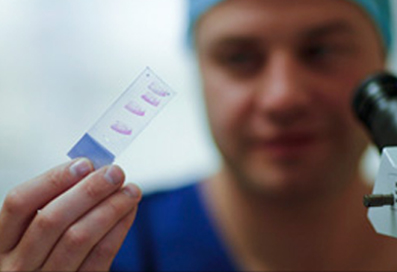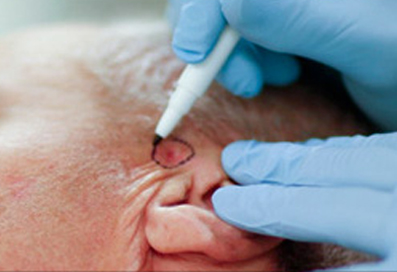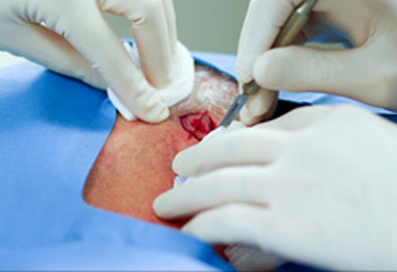
Mohs Surgery is a highly specialised procedure that ensures complete tumour removal and maximises tissue conservation, thereby minimising scarring and ensuring the optimal post surgical cosmetic result.

The Mohs Surgery technique relies on the accuracy of a microscopic surgical procedure to precisely identify and remove the entire tumour layer by layer while leaving the surrounding healthy tissue intact and unharmed. Unlike other forms of skin cancer surgery, your tumour will be completely removed, analysed and the defect will be surgically reconstructed in the one surgical session.
- Your skin cancer will be completely eradicated to the root, resulting in a very high cure rate of up to 99% for even the most difficult and aggressive forms of skin cancer.
- It offers the highest chance for complete removal of the tumour while preserving the normal tissue surrounding it, thus reducing scarring.
Dr Banky is specially trained in Mohs Surgery, having undertaken an additional year of training in skin cancer surgery, pathology and reconstruction. Dr Banky’s qualifications to perform Mohs Surgery have been accredited by both the Australasian College of Dermatologists and the American College of Mohs Surgery. [See additional information about Dr Banky].

Mohs Micrographic Surgery is primarily used to treat basal cell carcinomas (BCCs) , Bowen's disease and squamous cell carcinomas (SCCs) on the head and neck area. It may also be used to treat less common tumours, including microcystic adnexal carcinoma and atypical fibroxanthoma.
- Is in a critical site where it is important to preserve healthy tissue for maximum functional and cosmetic results – this includes the nose, lips, eyelids, ears, fingers, toes, genitals and neck. BCCs and SCCs are also known to behave more aggressively and spread further under the skin in these sites.
- Was treated or excised previously but returned (recurrent tumours).
- Is located near scar tissue.
- Is large.
- Does not have clearly defined margins that can be visually seen or physically touched.
- Is growing rapidly or uncontrollably.
- Demonstrates ‘aggressive’ features on the biopsy analysis.

During Mohs Surgery, your skin cancer will be removed in stages, one tissue layer at a time. Your cancerous tissue will be examined by Dr Banky microscopically, enabling him to precisely identify and remove an entire tumour layer by layer while leaving the surrounding healthy tissue intact and unharmed. This minimizes the chance of re-growth and lessens the potential for scarring or disfigurement.
- The visible portions of your skin cancer are surgically removed.
- The excised tissue is marked and mapped and prepared for microscopic analysis.
- Each section of tissue is microscopically examined for evidence of remaining cancer cells.
- Any remaining cancer is then precisely removed from the location identified through microscopic analysis and mapping – this ensures that the maximum amount of healthy tissue is kept intact.
- Once the cancer has been completely removed, post-surgical reconstruction options will be discussed with you. These may include side-to-side suturing, a flap, graft or in some instances spontaneous wound healing under a dressing (‘secondary intention’ healing).
Mohs surgery is an outpatient procedure performed under local anaesthesia. Your surgery will typically start early in the morning and is usually completed on the same day.
It is difficult to predict exactly how long each individual surgery will take because the time frames are dependent on the extent of the skin cancer and the amount of reconstruction that is needed.
In general, each ‘stage’ of Mohs Surgery (that is, the process of cutting out the tumour and analysing the edges under the microscope) takes approximately one hour.
Thirty-three percent of cancers are cleared with one stage of Mohs Surgery. The vast majority are cleared on the second stage. Only approximately 10% of cases require 3 or more stages.
It is suggested that you bring a book, magazine or iPod to keep you occupied in the time between stages. Your surgery is likely to take half a day, and you are required to remain in the hospital between stages.
- For more information about Mohs Surgery you can visit the American College of Mohs Surgery website.
- View the Mohs Surgery Photogallery

 03 9519 9500
03 9519 9500